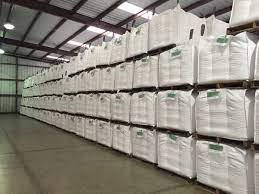Last Updated on February 8, 2025 by Bisma Sehar
Flexible intermediate bulk containers or FIBCs are more commonly referred to as bulk bags and are a cost-effective transportation and storage option for many types of bulk materials. They are made from strands of polypropylene, a synthetic plastic that is strong, durable, flexible, and reusable. Almost every industry uses FIBC bags because they are one of the best ways to store and transport oddly-shaped items, heavy bulk materials, and even dangerous dry chemicals.
Table of Contents
Agricultural Products
FIBC bags are ideal for storing and transporting many agricultural products because there aren’t very many containers that can handle a large volume of loose seeds, grains, and other materials. Since these bags can hold up to 3,000 pounds of product, farmers can easily get their products from the field to the processor or manufacturer in bulk quantities. Moreover, farmers and ranchers often have to supply large amounts of feed to their livestock, which is best stored in flexible bulk bags.
Food-grade bulk bags can ensure their contents stay dry and unspoiled for long journeys, meaning farmers will suffer less loss by using these bags to ship their products. There will also be less spillage than boxes or other types of containers that can come apart or have seams where the product can leak out.
Agricultural businesses also use FIBC bags for transporting fertilizer to farms for use in the fields. Large farms use massive quantities of fertilizer, and it’s much easier to ship and store in bulk bags than trying to purchase the smaller bags of fertilizer from their local hardware or landscape stores. In addition, FIBC bags can be reused, cutting down on both waste and expenses for farmers and agricultural suppliers.
Powders and Fine Grains
FIBC bags are tightly woven, allowing powders and fine grains to be transported with little risk of spillage. The type of bag used will depend on the material because some powders require a specialized bag to ensure no static electricity builds up and ignites the contents. For instance, Type A bags can be used for any non-flammable product and when there are no flammable gasses or solvents in the area where the bag is stored or loaded.
Type C and D bags are best for flammable chemical powders or in an environment with flammable gasses or solvents. The difference between the two types is that Type C includes a grounding point that prevents static electricity from discharging and potentially igniting the contents of the bag or the air around it. Type D is made from antistatic and static dissipative materials and does not need to be grounded.
Landscape Materials
Landscape companies that use large quantities of rock, pebbles, cement, and other heavy materials will discover that FIBC bags can easily handle these weights. Since some types of bags can hold up to 3,000 pounds of materials, there will only be fewer bags to ship and store instead of dozens of little bags. This makes better use of storage space and is more cost-efficient as well.
Read More: What Is the Wrapping Testing Method of Core Spun Yarn?
Conclusion
These are just a few examples of the types of materials that can be transported and stored in FIBC bags. If your business needs to include a way to transport bulk or bulky items, these bags might just be the solution to your problem.
Read More: The 4 What’s You Need To Know About Before Your NDIS Audit
















